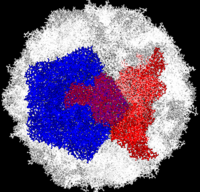ANTIVIRAL ACTIVITY of 3(2H)- and 6-CHLORO-3(2H)-ISOFLAVENES AGAINST HIGHLY DIVERGED, NEUROVIRULENT VACCINE-DERIVED, TYPE 2 POLIOVIRUS SEWAGE ISOLATES
Lester M. Shulman, Danit Sofer, Yossi Manor, Ella Mendelson, Jean Balanant, Anna Laura Salvati, Francis Delpeyroux, Lucia Fiore[1]
Molecular Tour

Complete Poliovirus 2 Viron based on PDB entry
1eah,
example of 3-fold symmetry is in red,
example of 5-fold symmetry is in bluePoliovirus is a member of the Picornaviridae. Like other members of the Picornaviridae, poliovirus RNA is encapsulated in an icosahedral structure with axes of three-fold and five-fold symmetry formed from 60 capsomeres containing one copy each
of viral capsid proteins VP1, VP2, VP3 and VP4 [1]. The binding site for the human
poliovirus receptor is located in a canyon at the five-fold axis of symmetry. The VP1 of
picornaviruses contain a hydrophobic pocket that is accessed through this canyon. This
pocket is normally occupied by pocket factors, sphingosine-like molecules including
palmitic and myristic acids and hydrophobic compounds, that stabilize the capsid and
whose removal is a necessary prerequisite for uncoating

